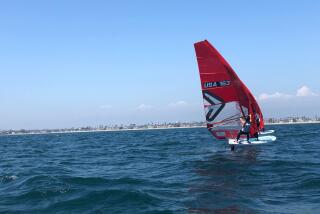Sailor Travels Rough Seas of Fund Raising
- Share via
CHICAGO — Bill Pinkney wants to sail the world on winds that carry dreams of hope back to schoolchildren in some of Chicago’s poorest neighborhoods. But months after his scheduled departure, the boat he will sail remains at dock.
“The worst seas I’ll face are the ones I’m facing right now, being this close and having it not happen,” said Pinkney, 54, who hopes to become the first black to sail solo around-the-world via the treacherous waters off the Cape of Good Hope.
“If the boat breaks at sea, that’s something that can be calculated. Kids can understand that,” he said. “It’s hard to explain to a kid why something like this trip can’t happen.”
After three years of fund raising, Pinkney is $250,000 short of an estimated $350,000 needed for the 11-month trip--an instructional voyage that has the blessing of Chicago’s schools.
By telephone and computer link-up from sea, Pinkney plans to give lessons ranging from simple geography to trigonometry. The instruction would include “the science of why things float--and more complicated matters: how boats are built, why boats sail,” he said in a recent interview.
“He came to see me . . . when he had put together his plan,” said Margaret Harrigan, who heads the Chicago Board of Education’s office of instructional support. “I thought it would be a marvelous boost for our education program.”
“We could find relevance in all areas of the curriculum--science, geography, literature,” subjects that could become more meaningful because of their association “with a real live Chicago hero.”
Pinkney grew up in a single-parent family in a poor neighborhood to become a marketing representative for Johnson Products Co., one of the nation’s largest black-owned businesses. He now devotes himself full-time to the sail, supporting himself through a commercial bakery he owns with his wife.
He has managed to attract funds from, among others, the MacArthur Foundation and Motorola Inc., but he is far short of the $240,000 price of the boat plus expense money for his trip. He is presently leasing the 47-foot cutter Commitment a single-masted sailing ship with two foresails.
“I’m very disappointed,” said Pinkney, who has the Commitment in storage. “What I’m talking about is so little money in the scheme of things. A television commercial costs $250,000.”
Ted Seymour, a black American, circumnavigated the globe by sail in 1987. Pinkney, who has been sailing for 26 years, said he would be the first black to accomplish the feat by way of the Cape of Good Hope, at Africa’s southern tip.
For some children he has approached, the delay seems unfathomable.
At a South Side school in the shadow of some of the nation’s largest housing projects, some students “think we have our priorities wrong,” said science teacher Joan Preer.
“The kids think: We have money to spend for everything except for the things that would be truly important to American citizens,” said Preer, who teaches the seventh grade at the Beasley Academic Center, a public school.
“The kids have asked me, but I haven’t been able to give them any answers as to why he hasn’t left yet.”
Pinkney recently attended a convention of the National Black School Educators, hoping to attract districts across the nation. He hopes that the more schools he signs up to participate in the ship-to-shore classroom, the easier it will be to attract sponsors.
He has interested some more affluent schools, but basically, it is impoverished minority children who “need to see that someone that has a similar background to them . . . can rise above it,” he said.
Pinkney, who originally hoped to sail in October, now aims to launch Commitment from New York this spring.
More to Read
Sign up for The Wild
We’ll help you find the best places to hike, bike and run, as well as the perfect silent spots for meditation and yoga.
You may occasionally receive promotional content from the Los Angeles Times.






